One of the most important things a backpacker can find is a great travel backpack. It holds all your gear, it’s with you almost all the time, and in some bizarre, anthropomorphic way, it’s your best friend. I still remember the feeling of coming back from my first solo backpacking trip, and walking around without a backpack. It felt wrong. Like something was missing.
Over the years, I’ve gone through packs like nobody’s business. I’ve never used the same pack for more than two trips, and no matter how many hours I spend either online or in the store, it seems like finding the right pack is always going to be a horrific ordeal.
Discomfort, poorly designed features, dangly straps, sizing issues, and all manner of nonsense have thwarted my path at every turn. It’s tough finding something that fits you properly, and I think, given the high user ratings of certain packs I hate, maybe I just have a bizarrely crooked spine and it’s not their fault.
But I refuse to let them get away with rant-free ease.
“Travel” packs barely exist
Part of the problem is that, up until very recently, the only options were top-loading hiking backpacks, or wheeled suitcases. Other options like duffel bags or school backpacks exist as well, but these are rarely suitable for round-the-world travel.
But since these were the only options, accepting their flaws was all I could do. And besides, high-quality hiking backpacks will stand up to most abuse, and they’ll be super comfortable if they fit you properly. But they’re not ideally suited for travel. Hiking packs work, but we’ve only been using them because nothing else was better.
The problem(s) with hiking backpacks:
Now don’t get me wrong; hiking backpacks are great, and I’ve used them on plenty of trips. Some designs have none of these flaws; it’s just that they usually do:
- Packing inconvenience: Hiking packs are usually top-loading, cavernous cylinders that swallow your gear and you have to dig everything out to find whatever’s at the bottom. You can mitigate this problem with packing cubes, but suitcase-style openings are so easy to manufacture that it’s insulting how rarely they’re implemented.
- Extraneous strap dangle: Hiking packs have all sorts of compression straps and attachment points. These are useful for walking around, but they’ll get scratched up when you throw them in the luggage compartment for a bus ride. And I’m including shoulder and hip straps here, too. If you ever have to check your bags for a flight, they’ll come out a little more damaged every time.
- No locking mechanism: Top loaders usually use a drawstring opening, which offers no security whatsoever against unscrupulous hostel bunkmates. This problem can be mostly solved with a laptop sleeve that can lock itself to a bed, but lockable zippers would be easier (though I’ve softened this requirement, as zippers can be easily bypassed, even when locked).
And in many cases, plenty of hiking packs have dumb design errors anyway, even if you’re just hiking.
The problem(s) with so-called “travel backpacks:”
Several companies design what they call “travel backpacks,” which have better features, solving some of the problems listed above, but they generally screw things up in the meantime as well:
- Size: They’ll make them so gigantic that you have to check them on a plane. Some of these “travel backpacks” go up to 80 liters. I’ve done RTW travel with 20. The carry-on max of 45 liters is plenty! Who the hell needs 80?!?!
- De-hydration pockets: They’ll skip the damn water bottle side pockets and then where the hell do they go?!?!?
- Filthy dirty lie “panel” loading: They’ll forget to make the suitcase-style opening go all the way around, thus defeating the purpose of the panel in the first place.
Sigh.
Which is why I’m so gleefully pleased that certain companies have been designing travel backpacks. Correctly, I might add.
I don’t know why the other people didn’t bother doing it before.
What the best travel backpacks get right
I’ve compiled a list of some of the best travel backpacks for carry-on use I can find. These packs are made for travelers, not hikers. They’ve got panel-loading convenience, not top-loading caverns; they’ve got lockable zippers, not drawstring uselessness; they’ve got carry-on dimensions, and minimal, hide-away straps, not monstrous bulges and streamers hanging from every angle. They can be carry-ons, or they can be checked luggage, without getting ruined.
Oh, and they’re not ugly. To me, that counts. Who the hell ever thought fluorescent orange was sexy? The 80s? Yeah, stay there.
I’ve organized this list by type. Let’s begin:
Option 1: Full size and full-featured
These packs have everything you could want; maximized dimensions, panel access, a laptop compartment, and lots of internal and external organizational pockets. There’s nothing missing.
1) Tortuga Outbreaker Backpack
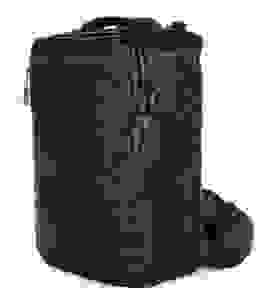
Tortuga was started by a random team of people who found themselves complaining about how they couldn’t find a travel pack that wasn’t awful. They’ve been outfitting nomads ever since.
Expected features on this pack include the full-length panel-loading design, to allow plenty of easy access to everything inside, and the dedicated laptop compartment opens fully flat, so you don’t need to remove your laptop at the security conveyor belt. The inside has even more pockets than the outside, and several compartments (the important ones) feature locking zippers. The “organizer panel” compartment is my favorite feature, with slots for pens, cards, and other small items, and the sheer number of pockets, both inside and out, will offer more organization than anything else you’re going to find.
Tortuga is currently on the third version of this pack, and the new design has a height-adjustable suspension system, meaning it will fit people of all sizes. It also has a seriously padded hip belt, which is rare for these packs, along with a seriously cushioned back panel (with raised ventilation) and shoulder straps. It’s the most heavy-duty suspension system of any travel pack out there, and although it’s significantly heavier as a result, it’s going to excel at carrying heavier loads. They’ve eliminated the ability to stow the shoulder straps and the suitcase handle, however, emphasizing its backpack features exclusively. The side grab handle is also gone, replaced with an extra mesh pocket.
It’s available in 35 and 45 liter capacities, to match the carry-on size requirements of European budget carriers, or North American airlines, respectively. I would say that because the pack features such a heavy-duty suspension system, it actually makes more sense in the 45 liter version. With a full load at that size, you’re definitely going to appreciate the extra cushioning, but at 35 liters, it might feel like overkill, especially since this is one of the heaviest packs out there.
Though Tortuga has released lighter packs, I much prefer the shoulder straps on this model, as they’re much more comfortable on me than either of the new ones they’ve released. If you’re looking for a 45 liter pack, this is as feature-rich as it gets, and definitely one of my top choices at that size.
You can get it from Tortuga. Their blog is also great, with all sorts of packing and travel tips.
Update: I received a test sample of the 35 liter version of this pack, and put it to the test! Check it a detailed review here.
2) Rick Steves Convertible Carry-on
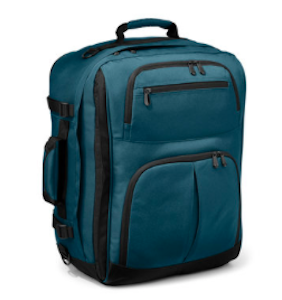
Long before anyone else got started in the carry-on travel backpack game, Rick Steves was galavanting around Europe with his own personal travel gear, designed exactly the way he liked it.
He gave it the features that later became standard on other packs, such as a fully opening panel that allows easy access to everything inside, along with hide-away backpack and waist straps, and suitcase-style grab handles. Exterior pockets are also quite generous, including a dedicated laptop compartment that became a later addition in an updated version.
But it has a few extra touches, such as a separate interior compartment for shoes or dirty clothes, and includes two mesh bags and a removable documents pouch, which you can remove and take with you instead of leaving it in a room. Lastly, the pack is sized to accommodate North American carry-on dimensions, but can expand with a compression zipper in case you stock up on too many souvenirs.
It’s easily the most affordable option on this list, although they do recommend using packing cubes inside to create more structure along the back panel. If you don’t, it can sag quite a bit, putting the weight on your shoulders instead of your hips. The compression straps on the side help with this quite a bit, so just make sure to pack it right, or it’ll feel heavier than it really is.
You can pick it up here.
3) Pacsafe Venturesafe EXP45

Pacsafe is known for its anti-theft approach in everything they do, and this pack is no exception. Not only does it have lockable zippers, but it has zippers that are resistant to the “pen trick,” which is a method thieves can use to break into a pack, even if it’s locked. It’s a huge nuisance that travelers need to know about, but it’s solved here, by placing a redundant set of teeth on the opposite side of each zipper, which prevents a pen from breaking through the chain. It also has slash-proof materials, to prevent hit-and-run theft.
Beyond that, it has a fully-opening suitcase-style main compartment, a laptop sleeve and organizational area in the front, and tuck-away straps. The carry-on dimensions, multiple grab handles, and compression straps make it portable, and versatile.
Pacsafe currently makes this version in a few different sizes, and they have other Venturesafe models available as well (such as the Vibe and X40), but I think this one has the best combination of features, especially in terms of organization. The others are lacking some extra compartments, for example, making this one the most recommendable of their selection. I wouldn’t say it has that much organization, but the organizer panel goes a long way toward keeping everything neat and tidy.
Get it here.
4) GoRuck G2
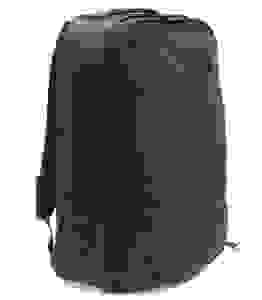
GoRuck has gained something of a reputation for designing some of the longest-lasting gear you can find, built for crazy endurance events and military use. They have packs of several different sizes (including multiple capacities, even if the packs have the same name), but the 40 liter G2 is the one I’m highlighting here.
The pack features a fully panel-loading design, a separate laptop compartment, and another exterior panel-loading compartment for extra organization. It also has those webbing loops all over the place for adding extra accessories or lashing gear to the outside, including a separately available padded hip belt, which I would call a necessity if you’re going for the 40 liter version. The sternum strap is also a separate accessory, so be sure to pick that up if you need it. You can tell it was originally designed for super tough, muscular guys, but it’s nice how they’ve accommodated scrawny weaklings with those extra touches.
As for the downside, the heavy-duty materials and construction make this pack heavy, and pricy…in fact it’s the heaviest and most expensive option listed here, but if you’re big enough to handle the heavier load and you want something that’ll pretty much last forever, the G2 is the one that’ll handle it.
The newly-developed G3, at 45 liters and with an integrated hip belt, nearly made the list here, but the slightly smaller G2 has that extra outside compartment for greater organization, so it just edges out the victory, at least in my opinion. Since the design doesn’t have much in the way of exterior organization, I think that’s an important feature. I do like the G3’s integrated hip belt, however, which is a more natural design element than the G2’s after-the-fact accessory hip belt add-on.
Pick it up here.
Option 2: Svelte and Slim
At 35 liters each, these are for lighter travelers who don’t need to max out on the size, but still want all the convenience of easy packing and laptop compatibility. They’ve got all the important features you’d want, in a slimmed-down size.
5) Minaal Carry-on Backpack
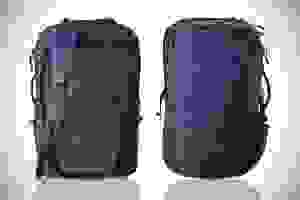
This one is yet another creation in the long, adorable line of things that were invented because people got sick and tired of endlessly having to deal with things that sucked.
This Kickstarter-backed project came about when two long-time travelers decided to make the pack they would have wanted. They set out to create the perfect travel pack for digital nomads, and its design (and Kickstarter success) just goes to show how rarely some of the major players stop to think about the needs of backpackers.
The Minaal has all of the major features you’d expect, including the fully-opening main panel, a separate laptop compartment, hide-away straps, locking zippers, multiple grab handles, and carry-on dimensions, even for the stricter European airlines. It has a few exterior pockets and internal dividers as well, along with a removable rain cover, and a removable, padded hip belt. It’s lighter and simpler than some of the larger packs, and it’s part of the reason I think this relatively minimal level of strap cushioning is kind of all you need at this size. The water bottle pocket is pretty tight, but there’s an elastic band in there that’ll hold taller bottles in place if necessary.
The pack is light, but also unstructured; packing cubes are definitely helpful here, especially since the main compartment tends to flop around quite a bit when you’re trying to pack it. The back panel isn’t too rigid either, so to keep it from sagging, using packing cubes and tightening the compression straps would be a good idea.
Get one here.
Update: This bag is now in version 2.0, and is even better than the original! They’ve sent me a test sample, and I’ve written about it in-depth here.
6) Cotopaxi Allpa 35
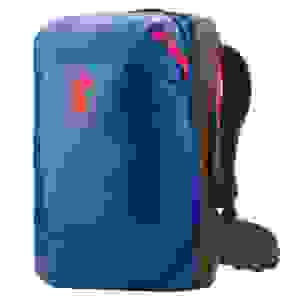
For those who love travel, but only in Punky Brewster colors. But don’t worry, it also comes in black.
This is a relatively new offering, but it does quite a few clever things that look great; it opens up like a suitcase, but splits the gear in half, rather than simply opening with a flap. It has a separate laptop and tablet sleeve, some exterior pocket access (including a way to access the main compartment without pulling open the main zipper), and a neat theft-prevention trick of leaving the zipper pulls on the opposite side of a webbing loop, where they’re hard to yank without fiddling with them a little.
The pack also has a number of optional accessories, such as an external mesh water bottle pocket, to add some customization. The extremely curvy shoulder straps (which tuck away when not in use) are also angled properly for smaller people with more angled shoulders, which I think is actually most people. It even throws in a rain cover, and the price is extremely competitive. I like the way it splits up the main compartment, giving you even more organization instead of using just one big space for everything, and also how it allows you to access those areas without opening up the main zipper. Plus it has those mesh doorways to keep everything in place, so you won’t make a mess even if you need to open up the main compartment. I suppose it could use a bit more mini-organization for pens and cards, but that’s about the only issue I can see.
The lower-right picture shows the pack with optional accessories, like the daypack and laundry bag, available separately.
Get it here.
7) Gregory Border 35
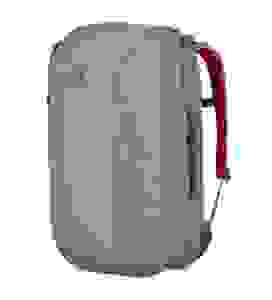
So Gregory is primarily a hiking pack company, and not as widely known as some of the bigger names in the industry, but whose packs I think are designed better than many of its competitors.
Their Border series consists of urban/travel backpacks, and this 35 liter version has not only a full-length panel-loading main compartment, but also a full-length panel loading laptop compartment; this means you just unzip and unfold this compartment, and lay it down on the airport security scanner, rather than removing the laptop at all. It’s quick and easy, and makes airport life just a little more convenient. The several exterior compartments allow for quick access, although there’s not a huge amount of organization here.
It’s missing a couple useful features, however. There’s no hip belt, no side water bottle pocket, and you can’t stow the straps away to use it as a suitcase (although it does have side carry handles). At 35 liters, you might not have to deal with checking the bag, but keep it in mind. Think of it as a budget version of the Minaal. The overall layout is similar, but it’s missing a few of the extra details. Without a hip belt, this’ll work better for larger people, or those who don’t plan on walking around too much with it, such as those who prefer taxis instead of hauling gear across town.
Option 3: Convertible shoulder bags
These options transform from backpack to shoulder bag, so you can carry it whichever way you want.
8) Tom Bihn Aeronaut
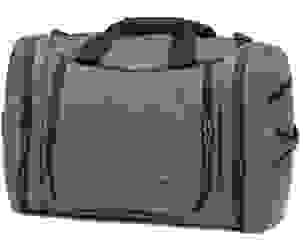
Tom Bihn is known for exceptional attention to detail, tiny little organizational perks, and super tough materials. They tend to win over fans for life, and that’s how long their bags seem to last, too. Many of them end up collecting the whole set.
They also provide far more compartmentalization than most other options; instead of one big compartment and a few extra pockets on the outside that are really just flat slots, they tend to have multiple three-dimensional areas, for splitting up large items, and not just little ones.
Pictured is the Aeronaut, a convertible duffel bag with disappearing backpack straps that zip away when you don’t want to use them, along with an optional waist strap, and an optional shoulder strap for shoulder bag mode. The main compartment opens up with a U-shaped panel, allowing for far more convenient loading and unloading than a typical straight-zipper duffel would allow, and the spacious side compartments on either end allow for plenty of organizational access, even for large items, without having to open the main section. The 45 liter version is a full-size pack, but it comes in a 30 liter version as well, for those strict European carriers.
Though it has plenty of compartments, it doesn’t have anywhere specifically intended for a laptop or a water bottle, though you could easily find homes for these somewhere in the setup. Also, keep in mind that the optional hip belt is just a strap, so it’s better for shorter walks. I tend to think of this design primarily as a duffel bag, with the option of backpack straps if necessary, but with the minimal hip belt and non-meshy back panel (which is just the regular exterior fabric of the rest of the bag), I’d try to avoid all-day use while in backpack mode with this one.
Get it here.
Update: I got a chance to test the smaller version of this bag (30 liters), but the features are identical, so if you want to see a ridiculously detailed review, take a look here.
9) Patagonia MLC
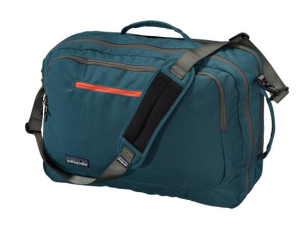
The MLC stands for “Maximum Legal Carry-on,” and thus it’ll give you plenty of room. It opens up all the way like a suitcase, but splits the cargo in two, storing some of it in the “door.” This keeps things more organized than a standard compartment, especially for dividing clean laundry from used clothing. Exterior compartments round out the organization as well.
It has carrying handles, a shoulder strap, and backpack straps, a laptop compartment, and Patagonia’s ironclad guarantee. It’s a solidly built carry-on that’ll last you for years. I will say that because it’s primarily designed as a shoulder bag, without a mesh back panel and no hip belt, that it’s better to think of this as a shoulder bag than a backpack. You might be fine carrying it through an airport for a little while, but you probably wouldn’t want to go on any long walks or hikes with it. It does have a sternum strap, so that helps, but I wouldn’t think of it as a dedicated backpack.
This model is known as the “Headway,” although they have another version known as the “Black Hole” MLC, with a super weather-resistant fabric.
Pick it up here.
Option 4: From the outdoor world
These last few options are from outdoorsy companies, whose travel-specific options are also pretty solid.
10) REI Ruckpack 40
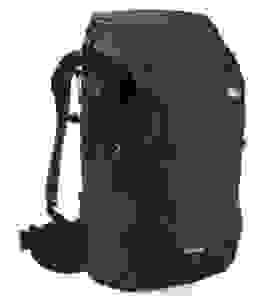
REI has had a place on this list for quite some time, although they’ve changed things up with new models every so often; the current incarnation of their travel pack is the Ruckpack 40, available in both men’s and women’s versions.
The Ruckpack is geared a bit more toward the outdoorsy crowd than digital nomads, with super-tough straps and a giant hip belt, but no laptop compartment. There’s a hydration bladder sleeve that could double as a laptop sleeve, but you’ll need to bring your own cushioned sleeve if you want protection. That’ll work, but it’s definitely more outdoorsy than tech-oriented, especially since it throws in a rain cover.
Still, it’s (nearly) a full-size pack, with a serious suspension system, which is easily its best feature, especially compared to some of the other minimal packs that are more for airline transportation than long hikes. It also has easy access from both the top and the fully-opening front panel (integrated together with a single zipper), and plenty of exterior organization, including small pockets for lots of small items. Those outer pockets do have a compression strap over them, which is a little odd, since it limits accessibility, but it’s a minor safety feature as well, since it’s just a bit more fiddly to deal with than just a zipper.
It’s just a bit too tall to be a carry-on, but the good news is that the top pocket squishes flat, so that’ll bring you into compliance with strict airline requirements, as opposed to some of the other, more rigid designs that don’t allow this. And if you do check the bag, the straps tuck away.
Get it here.
That’s the men’s version, but don’t forget there’s a women’s version there, too (and for a much lighter but otherwise similar pack, check out their Trail 40).
11) Osprey Farpoint 40
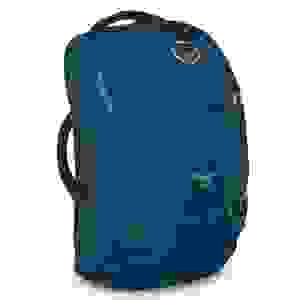
So I’ve decided to add this to the list, as it’s a popular pack with a great reputation, and it’s definitely worth checking out. It’s just that it does a few things that annoy the hell out of me, as is the case with all Osprey packs, but I’ll get to that in a minute.
First, the good: It’s a carry-on sized backpack with a full-length panel loading design, a dedicated laptop compartment, and hide-away shoulder straps. And those are good shoulder straps, and the waist belt is great, too. They really didn’t skimp on this feature, and it’s also available in two different torso length sizes, so it’s definitely going to be comfortable. And by the way, it’s probably going to be significantly more comfortable than the Osprey Porter 46, which is incredibly similar, but comes in just one size, and with daintier straps. I like how it has an organizer panel on the front, and its compression straps flatten things down by closing its semi-rigid sidewalls, which is a clever way to handle things.
And now, the bad: Osprey never ceases to amaze me with their insistence on using non-stretchy mesh water bottle pockets, with compression straps that go right over the pockets to make them a million times harder to use. I really don’t get it. I also find it to be something of a nuisance how the compression straps block access to the main zippered compartment, meaning it’ll be kind of a hassle getting into and out of the bag. The Farpoint has small external pockets, but the big ones are stuck behind the straps, in a way that annoys me a little more than some of the other packs listed here.
Still, it’ll definitely work, and its hiking pack pedigree means it’ll be a comfortable pack to carry. Another odd, but workable feature is how it carries the laptop on the side farthest from your back. I initially didn’t appreciate this feature, but as laptops become smaller and lighter, the weight distribution is less of an issue, and it protects it from getting squished between your back and the rest of the load.
Get it here.
(You’ll notice the larger versions have a detachable day pack, but not the 40 liter version)
So what makes a good travel pack?
You’ll notice that these packs generally have a number of features in common, some of which I mentioned as necessities, and some of which are easier to see once you line them all up in a row. These are the features of a good carry on backpack ideally suited for travel:
- Carry-on size: 45 liters is plenty for lifelong, indefinite travel all over the world. I did it in 20. You can do it in 45. And if you still want the “extra” pack for quick day trips, consider a compressible one. By the way, keep in mind that certain regional European carriers have stricter limits; 35 liters will likely be fine for them.
- Hide-away straps: But if you do want to check a bag, you certainly can. The straps tuck away so they can’t get snagged or damaged, which is also useful for stuffing them into overhead bins or under a seat.
- Multiple carrying options: You’ll notice each of these packs has at least two handles, always in the same place; the top, and the side. This allows you to carry it like a briefcase, or pull it out of an overhead bin. Plus, the aforementioned backpack straps and occasional messenger bag straps let you carry them however you feel like it.
- Internal compression straps: You pack the bag while it’s flat, then turn it upright. The compression straps keep everything stuck the way you packed it.
- Minimal external compression straps: No dangly silliness to get stuck on whatever. They’re useful, sure, but dammit, why don’t the hiking companies have the dangly end hang on to something so it doesn’t dangle?
- Laptop compartment: Our lives exist in the digital ether. I’ll tell people to skip the laptop if they’re not going to use it, but digital nomads need it, and most people will want one anyway.
- Locking zippers: It’s just that easy to keep your bag protected. Other bags have steel mesh reinforcements throughout the bag, but…the cost/benefit ratio isn’t so ideal. Locking zippers are easy, and hugely helpful (though I’ve recently seen techniques to bypass the lock, so I’ve softened on this as a requirement).
- Flat packing: The whole thing lies down so you can pack it like a suitcase. This is incredibly useful. I don’t know why it’s so rare in the hiking world.
Potential areas for improvement
I do, however, have some problems with certain aspects of carry on backpack designs. Now remember, I’m a nitpicky bastard that can never be satisfied, but dammit, it’s because I’m right. But keep in mind these are issues worth thinking about, rather than deal-breaking problems.
- Minimal hip straps: Transferring the load to your hips makes a huge difference. It’s the difference between “I need a massage” and “let’s go party.” For large, muscular specimens of masculinity, this is probably not such a big deal. It’s also easy to manage if you go straight from the bus station to the hostel, but I’ve often found myself wandering around town with my pack, and it’ll probably happen to you sooner or later as well. It would be nice to see detachable hip straps as an add-on option, though as mentioned, a few of the above options (Tortuga and REI Vagabond) have more serious hip straps than the others, and a simple strap can go a long way in improving the comfort of smaller gear setups.
- Minimal ventilation: This is another problem that arises from longer walks. If it’s winter or you don’t sweat much or you’re going straight to the hostel, good for you. If you plan on walking around for an hour, it’s going to be an issue. I’d normally say the trampoline-style back panel is great, but it’s tough to recommend it for the problems these packs are trying to solve. These packs are supposed to go through luggage checks with no problems, and the trampoline back would need to be protected in order to accommodate that. However, a raised lumbar pad and raised shoulder blade pads would go a long way in diminishing the ventilation problem, without sticking out too much.
- “Water bottle pockets” that don’t fit a water bottle: I’ll start by pointing out that most of the options above are fine in regards to this problem, but I will never stop complaining about inadequate water bottle pockets, because goddammit where the hell do they go?!?!
But again, these are just potential problems. The hip strap issue is likely the most objectively serious, and it’s definitely something to think about if you expect to be walking far and wide on your worldly adventures.
But, all in all, I like these designs. I also like the existence of these designs. I expect carry-on, hybrid packs like these to become increasingly popular, because they’re so efficiently designed to accommodate the needs of lightweight travelers who still need backpack straps, and once you get one…you’ll never need anything else.

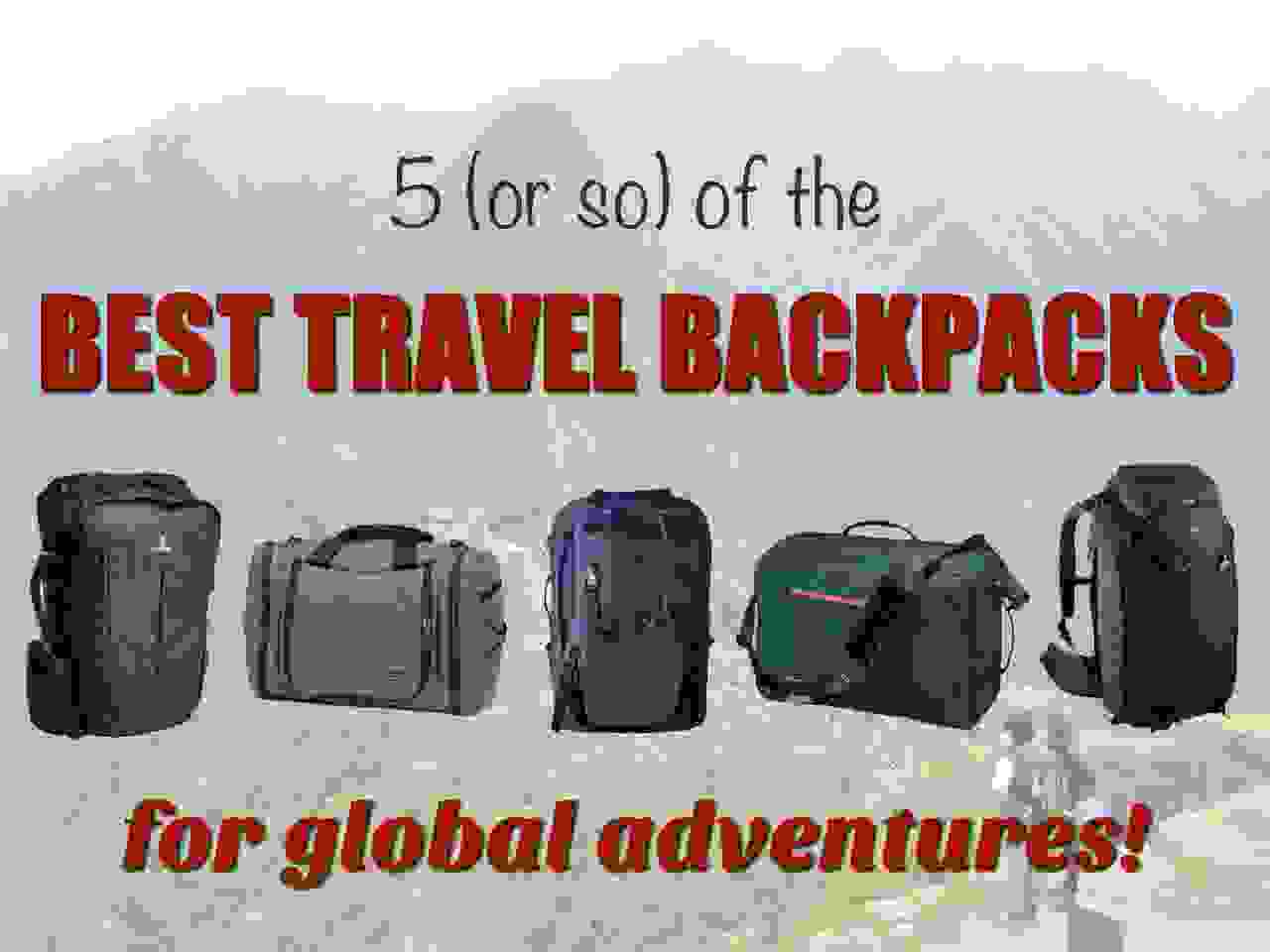
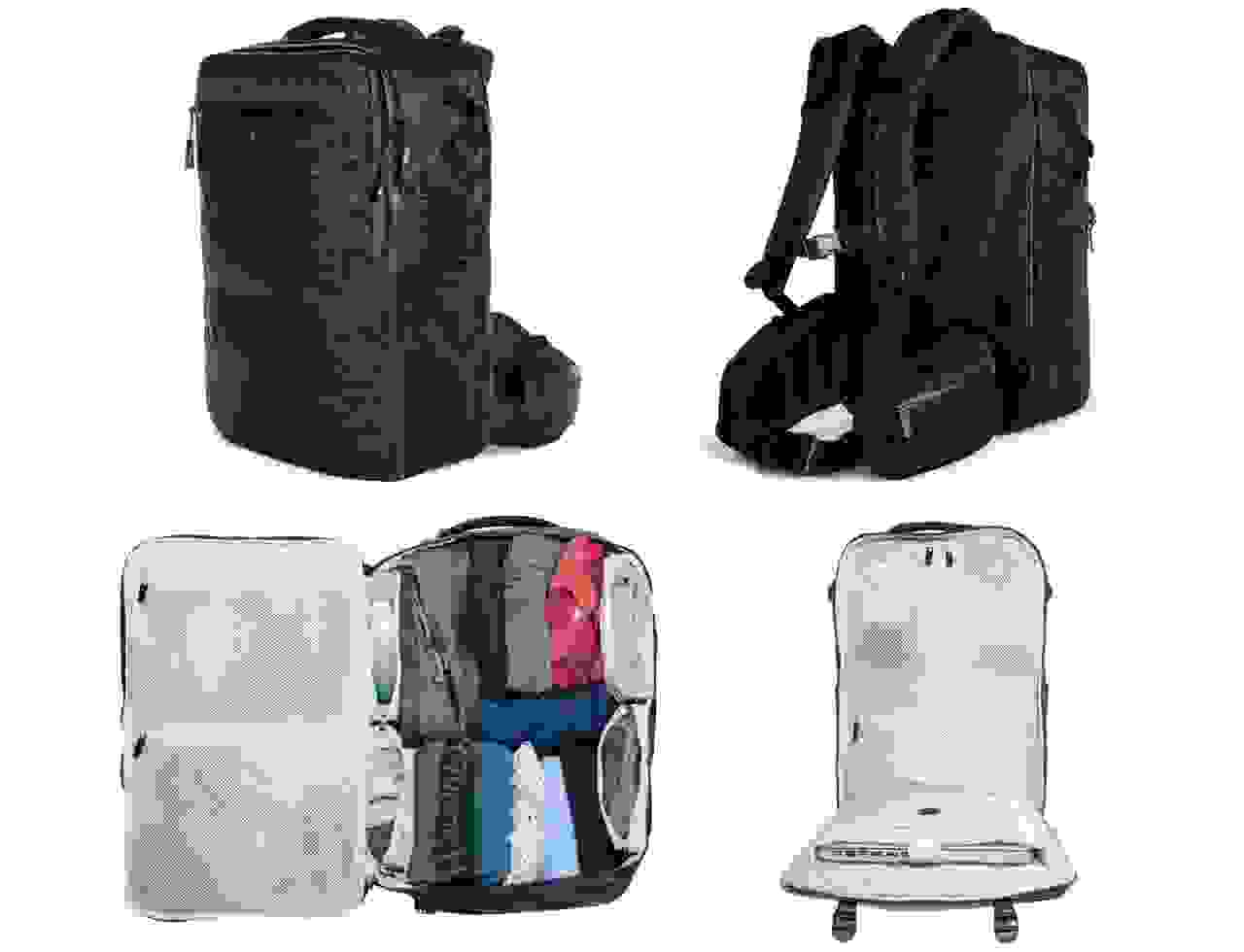
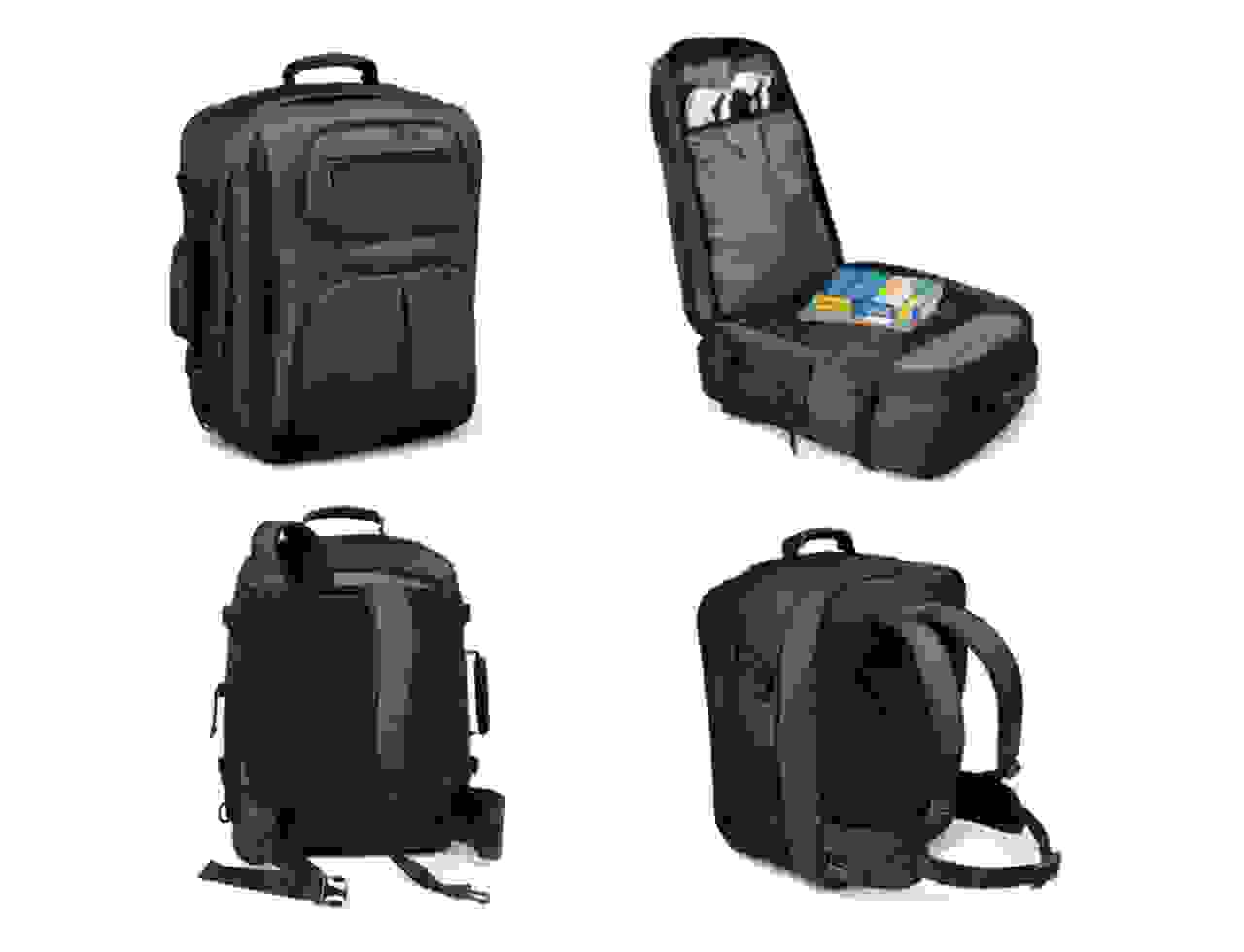
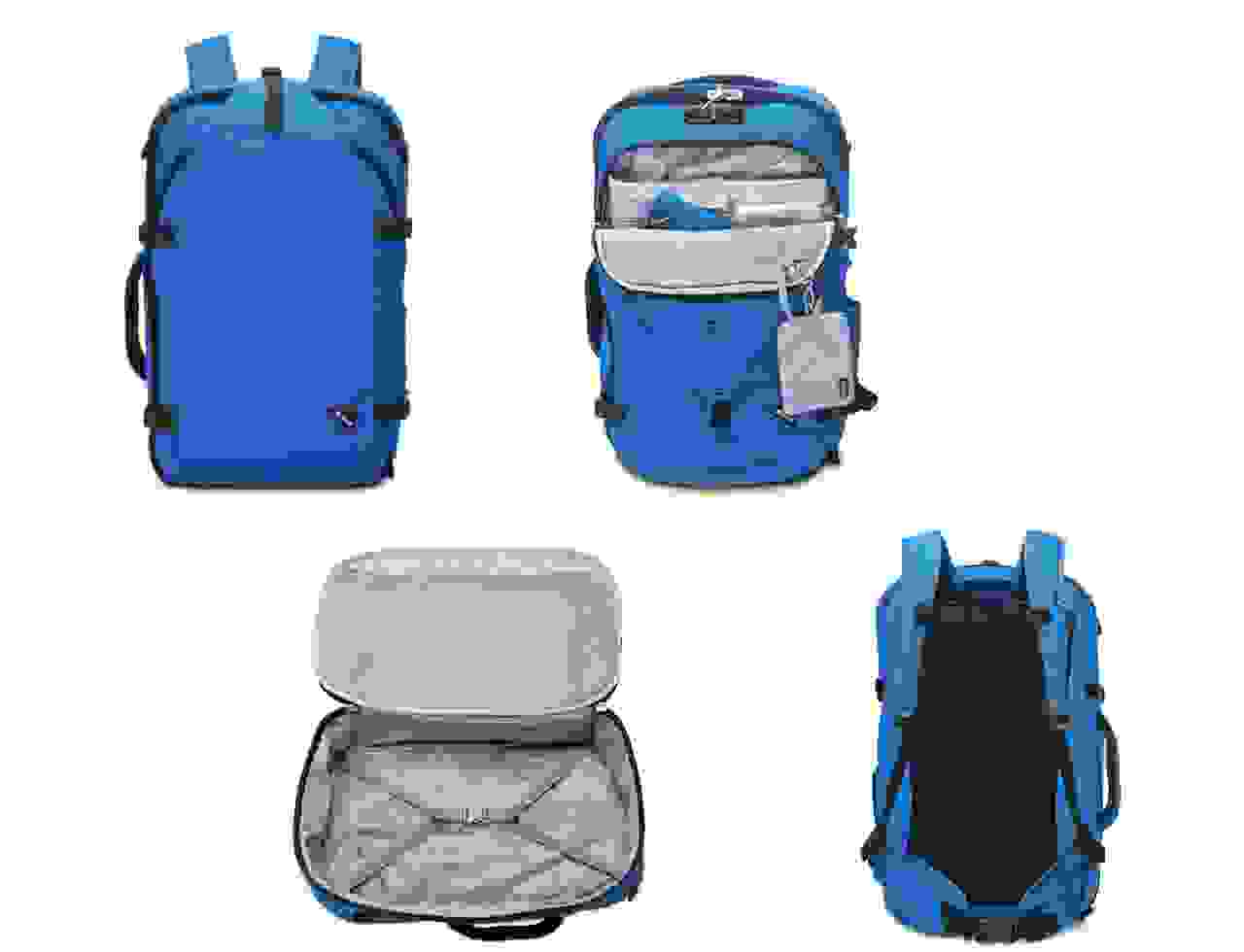
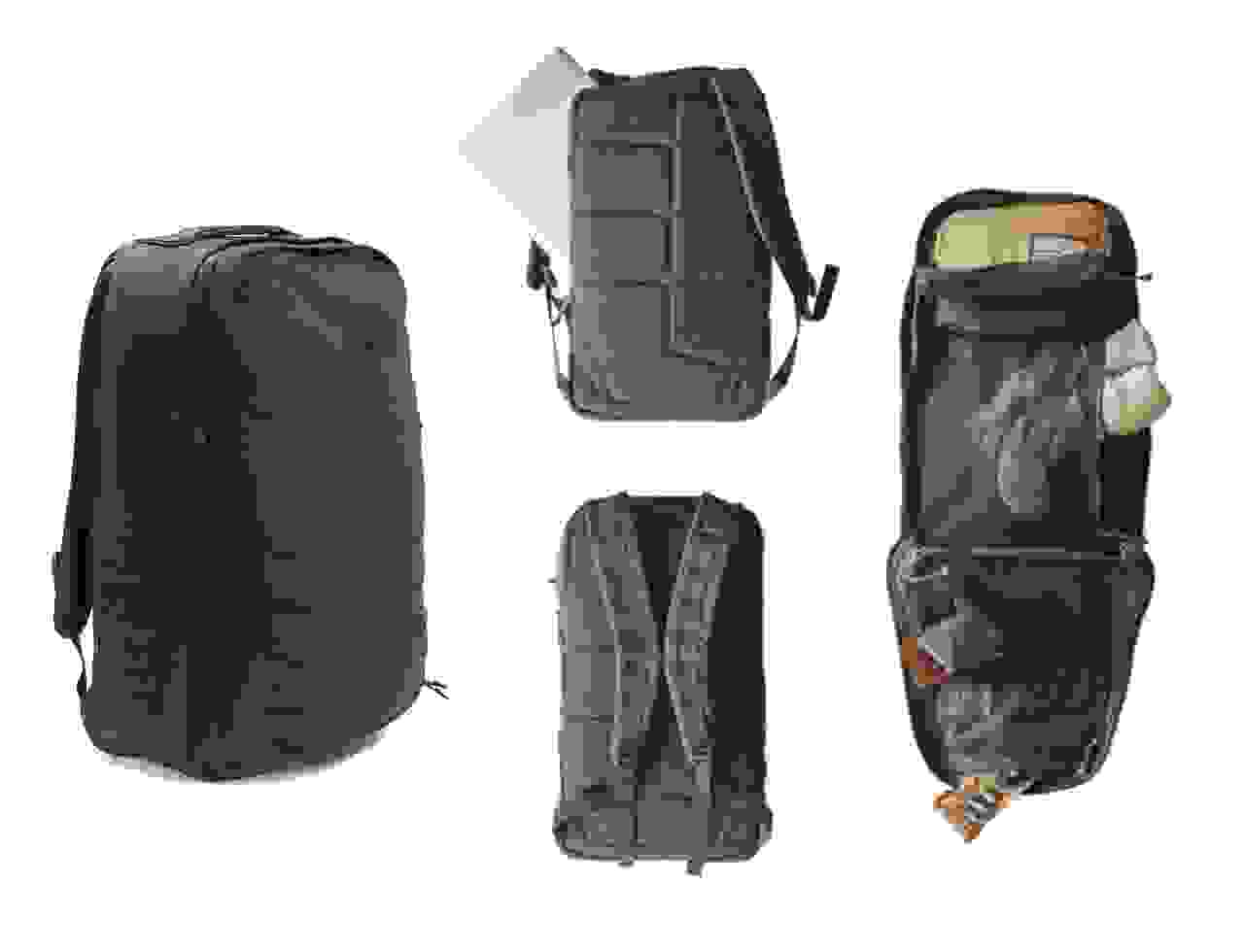
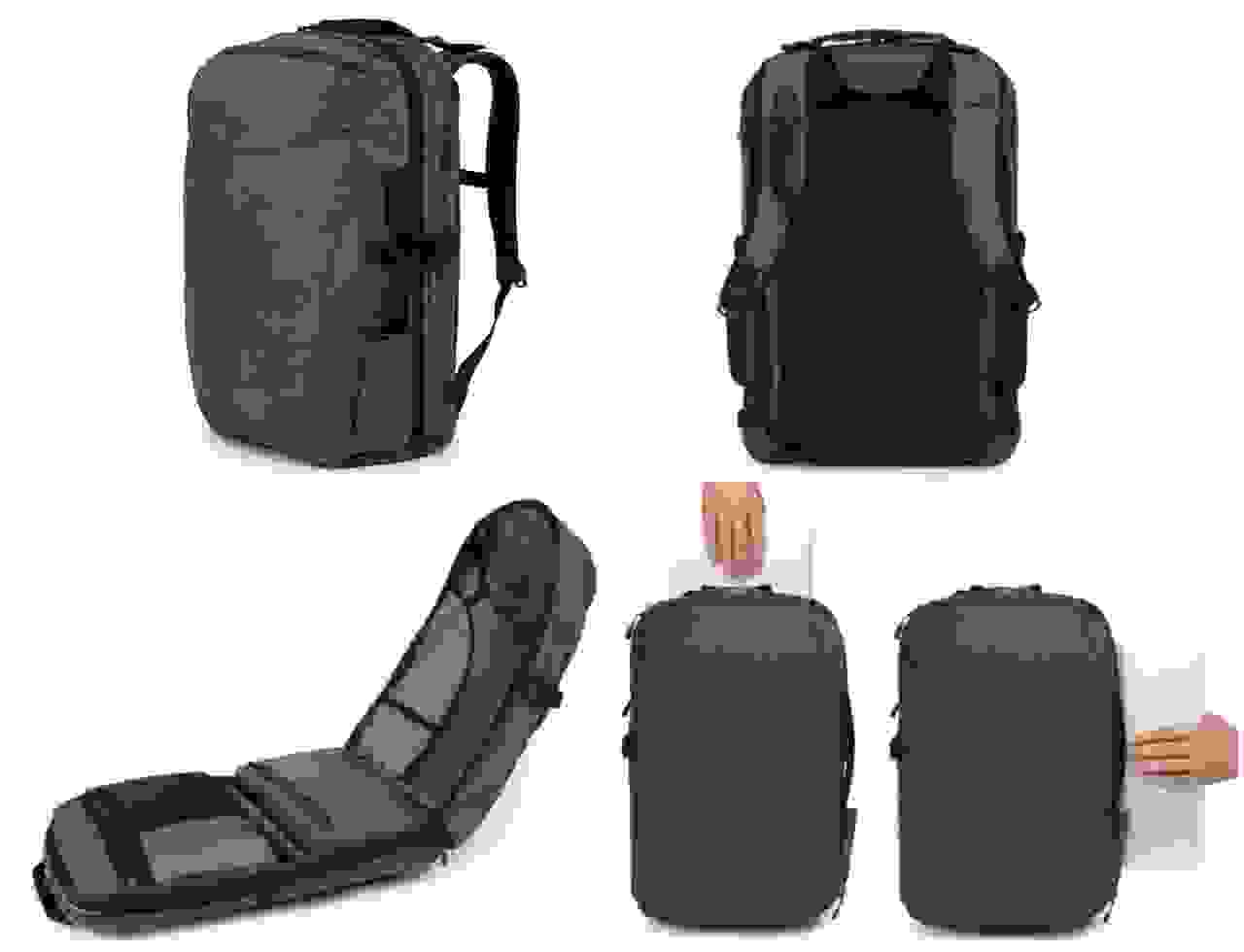
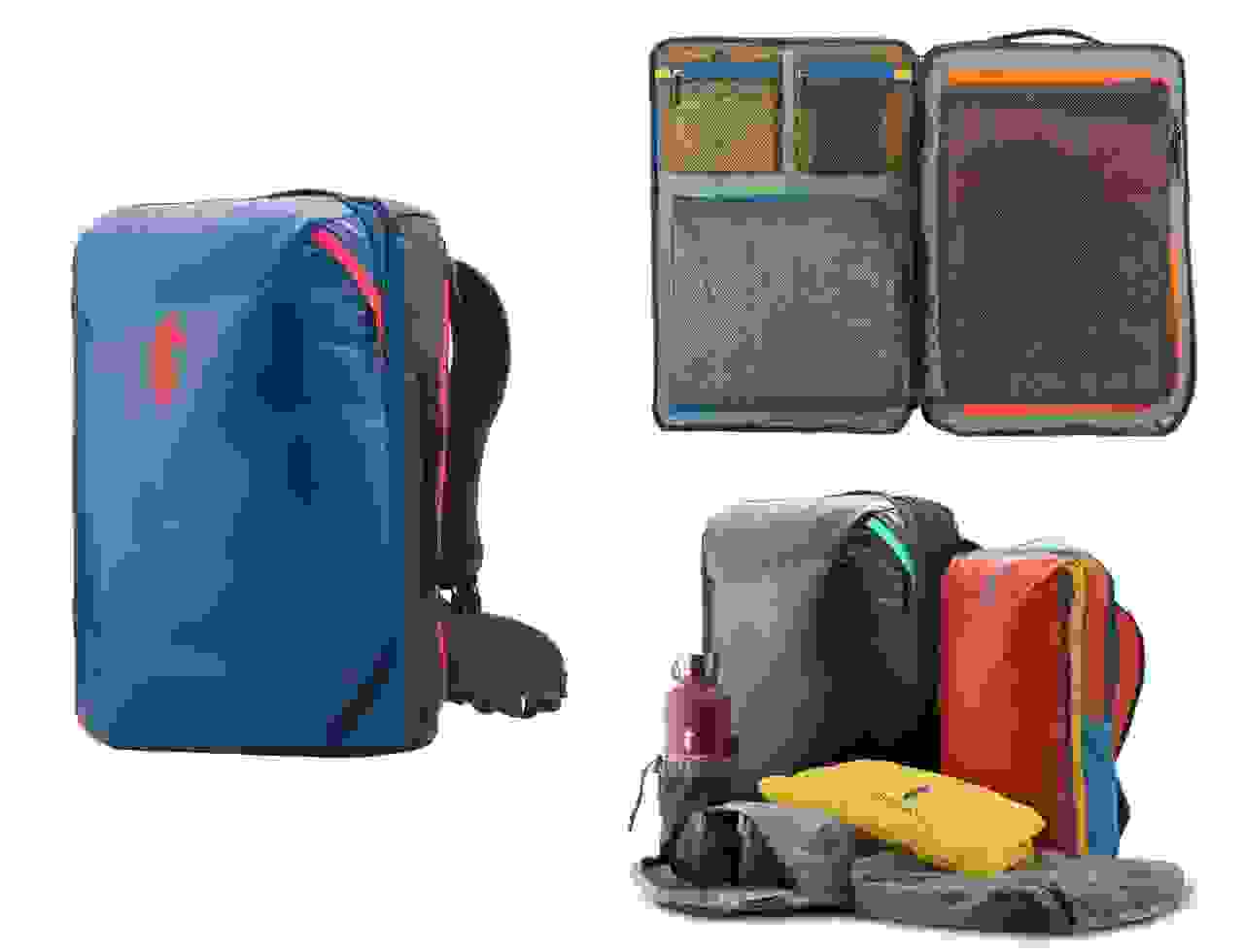
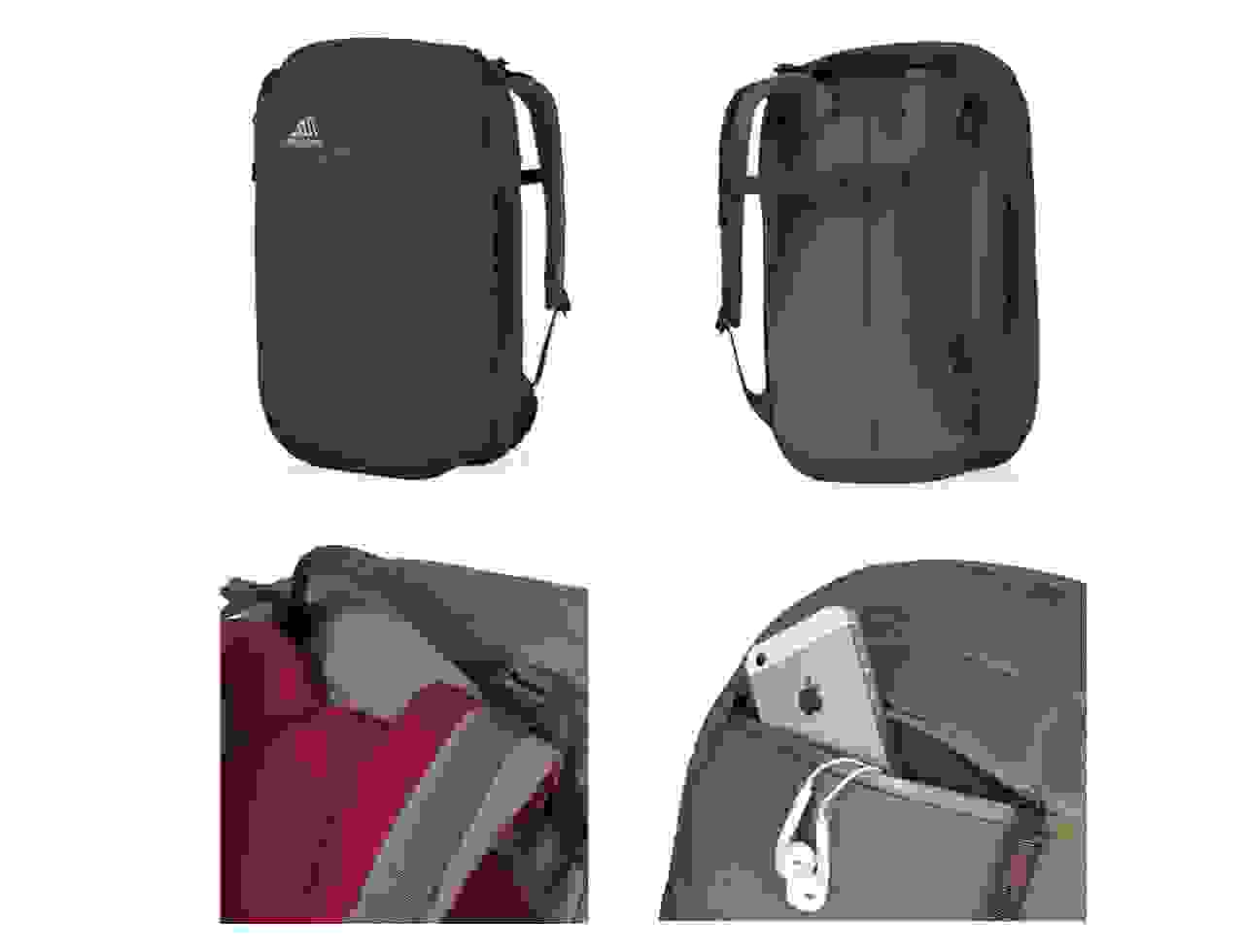
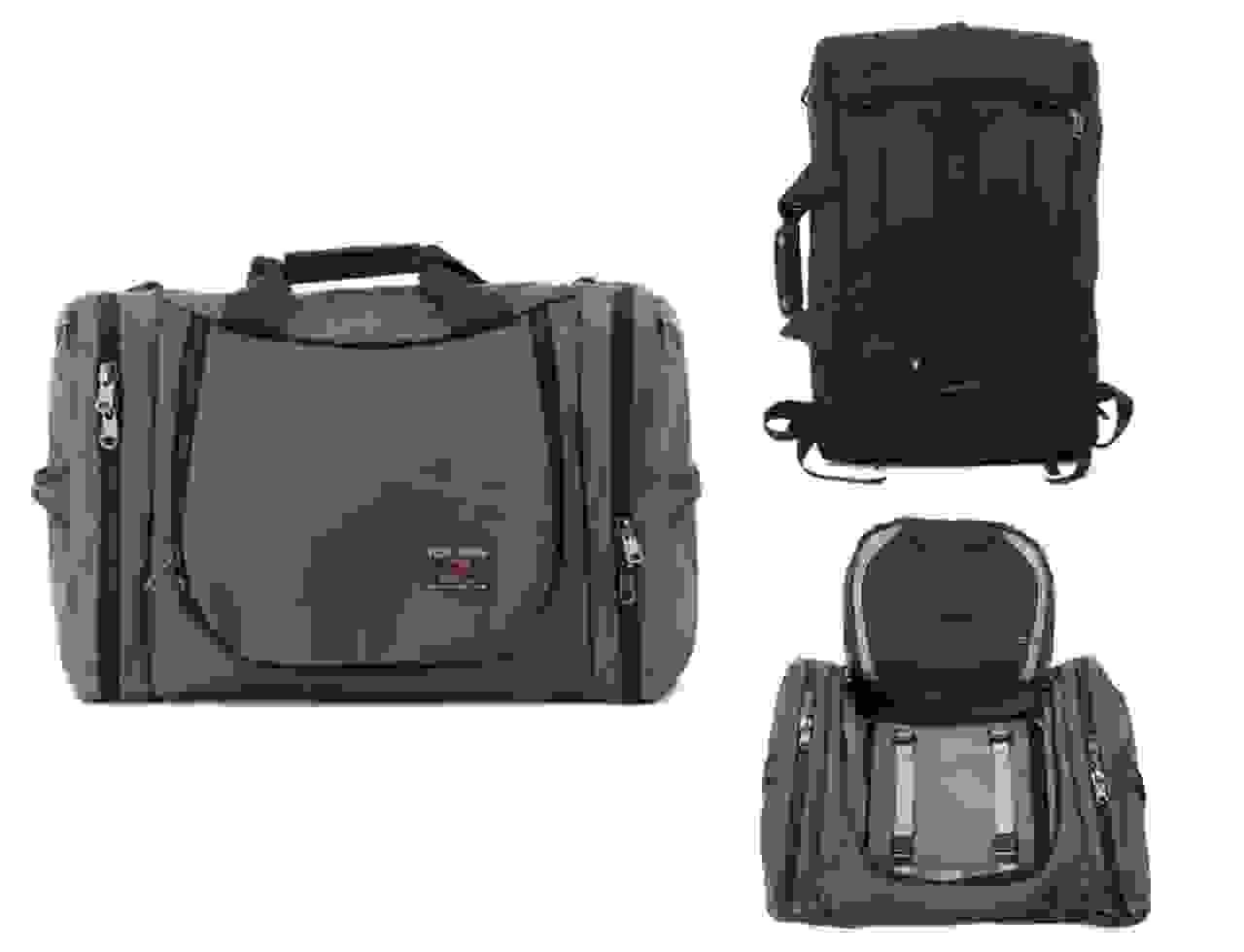
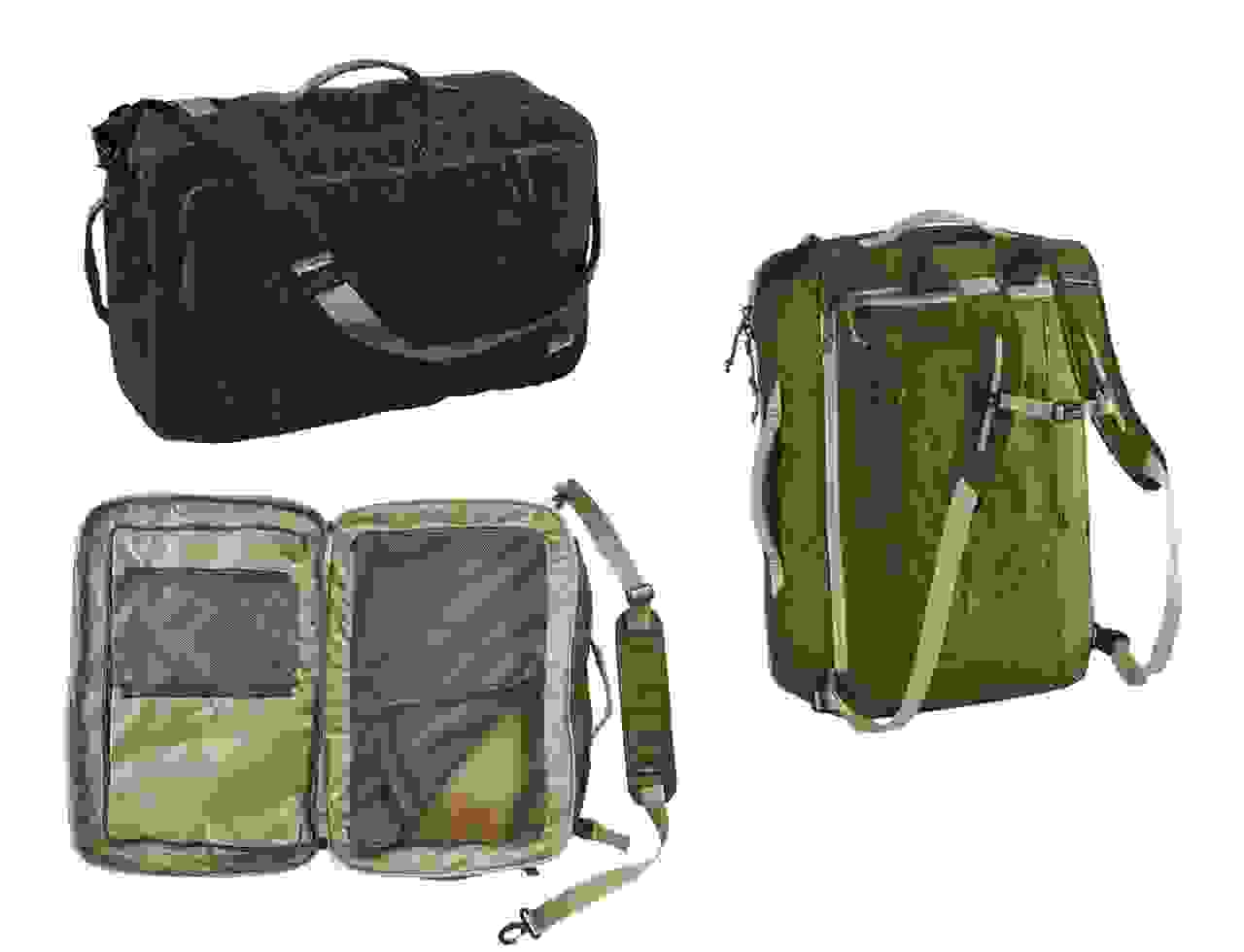
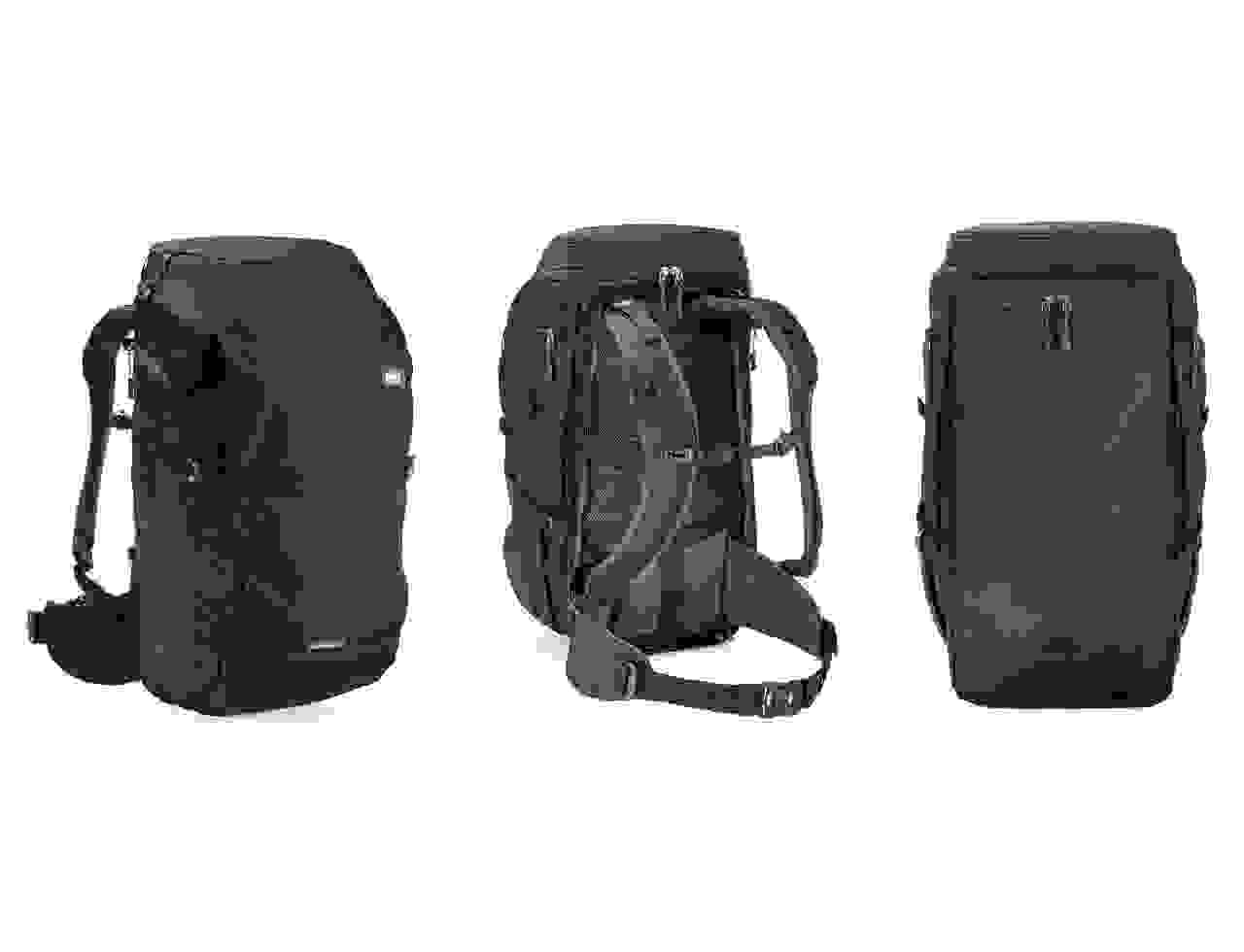
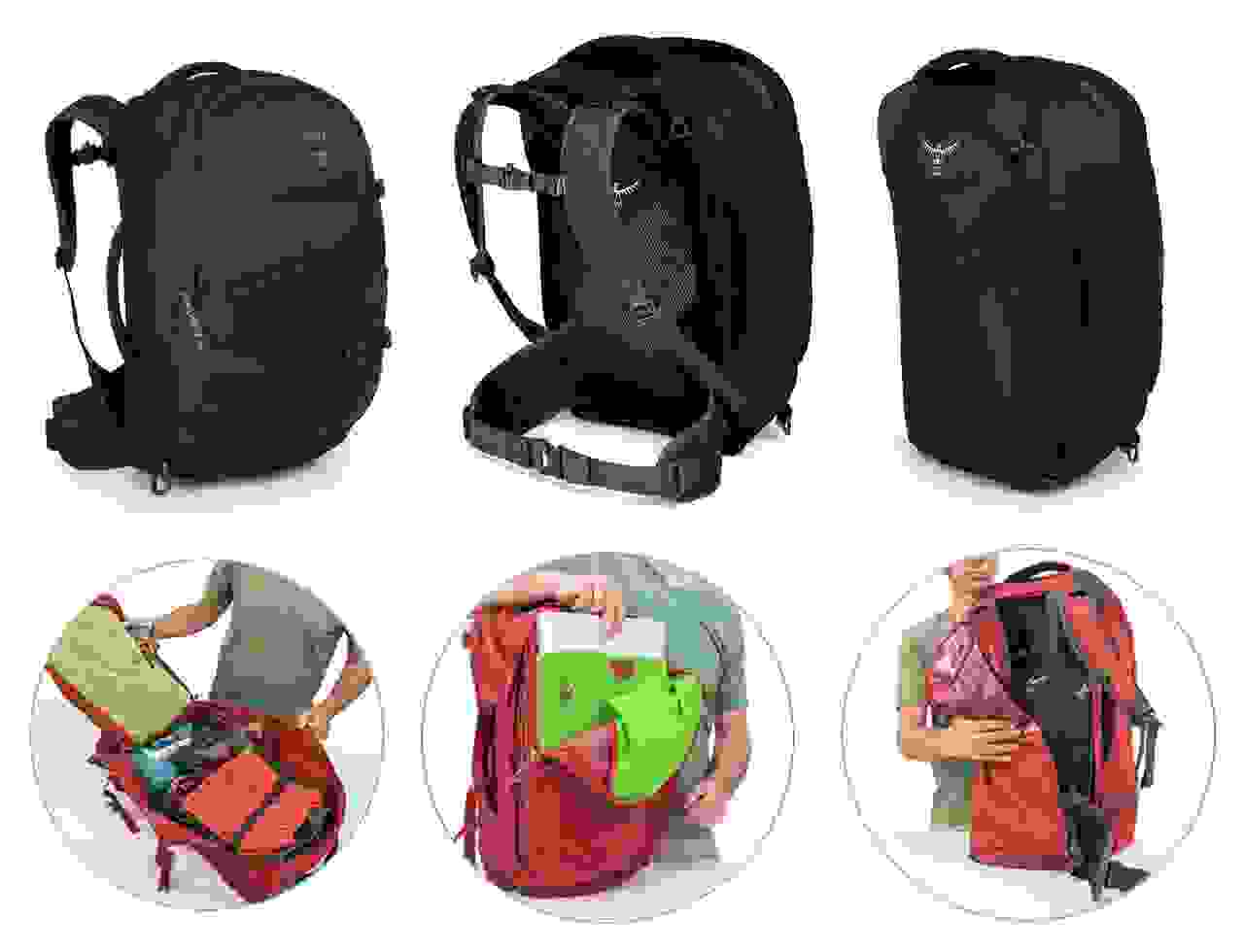



I am surprised you don’t discuss the Red Oxx Air Boss backpack and wonder what you think of it.
It was tricky deciding what should be on this list and what shouldn’t, and I couldn’t really come up with a perfect set of rules, so I just tried to include a number of varied but solid options. The Red Oxx looks perfectly fine, and it seems to have a good reputation. I just wanted to keep the list from ballooning to 50 different choices. Although that would have been useful in other ways, so it’s a bit of a pro/con thing.
I am a frequent flyer and I go travelling on my business trips quite often. Sometimes I take my daughter with me and she, just like me, has a plenty of accessories which need to be packed in a small size.
Any good recommendation on pink backpack with fashionable design?
Thank you for your information and please keep it up.
Hmm…I don’t know if I’ll be able to help much with that. Pink is definitely not my area of expertise. However, plenty of companies with good production standards cater to the female demographic, so what I usually recommend is just go to one of those companies, and just look for whichever option you think looks like the best. The North Face, Patagonia, and LL Bean will all do pretty well in this regard, and if you go to a store like REI, which has a good warranty as well, it ensures that everything in the store will be a solid option.
I recently got into the ultralight minimalist mentality (by accident). This started in the summer when I planned on taking a big backpacking pack and a camel-back style day pack for a two week Europe trip. When packing I realized that my REI Flash 22 Pack was able to fit everything that I viewed as essential, I initially pack every thing in Flash 22 because I knew the backpacking pack was too big for carry on and wanted to survive if that got lost in transit. The fact everything I viewed as essential fit into my small day pack surprised me, and after walking a bit with the big pack I decided to ditch that unneeded weight. All I really ended up leaving behind was the heavy bag, a change of clothes or two, a few books, and my contacts (which don’t pack as small as glasses). Then this Christmas I went on a two week trip to Israel. And decided to again use my REI Flash 22 Pack.
The Pack is by no means perfect which is part of how I stumbled upon this site, but it did get the job done and has given me the minimalist travel bug.
The two major problems I have with the REI Flash 22 Pack is that it is top loading pack, and what to do about souvenirs that are purchased along the trip. In both of my previously mentioned trips I had a workaround for the lack of extra space/souvenirs. In the first I knew that I would be getting a complementary day pack part way through the trip which I could use for any Items I acquired over the trip. On the second trip I brought a roller bag with me merely to have the opportunity to have space for souvenirs (both for myself and for others). I could still minimize a bit (getting better packing jackets or doing without a 3rd change of clothes). But currently when traveling with everything (such as moving between hotels) I have to place my books in the stretching exterior pockets (which do stretch well and I can fit four or more books between them).
Being that I am still very new to minimalist ultralight packing, my notion pack volume really means is very limited (other than just the dimensions). The sound of a 35 litter pack appeals to me because it is universally a carry on. But on the other hand I don’t know if it would be big enough to be able keep my books on the inside (so that they can’t get rained on) and have room for some souvenirs. I am not necessarily looking to get big souvenirs, but with just the REI Flash 22 Pack there is very little room for any thing other than very small trinkets.
In other words what size pack do you think is the most ideal size, or most ideal for me based on what I have mentioned?
Firstly, get LASIK, and a Kindle, or some other e-reader. You can even read books on your phone, which most people bring along with them anyway. That’ll take care of quite a bit of room, especially if you previously brought several books at a time, and they used a large font and big margins. But I think if you can manage a 22 liter pack, then stick with a 35. That’ll give you the maximum space that you can still carry on wherever you go. You’ve already proven that you can handle it, so I wouldn’t bother going any higher if you don’t need to.
Great site. I am a flight attendant and all I do is travel across the globe with my old backpack. I probably just got used to it. But reading this article made me want to purchase a new one. Yes the waaaater bottle is a problem. I am currently using a Samsonite. The pockets are awesome but i needed more space since I needed to bring extra clothes too especially when the layovers are long.
Anyway, huge help and thanks.
No problem. Always happy to help.
Came across your site while looking for advice on minimal travel packing, and loved it. You crack me up! Thought I’d throw in my two cents on traveling. We travel pretty extensively (a number of months a year, 30 countries and counting, both budget and business travel depending on why we are there). After years of using a Northface Terra 35 day pack (looked a bit tatty once I’d outgrown backpacker status), and then hauling a roll-aboard Samsonite suitcase along (better, but awful in the rain), I’ve switched to the Osprey Porter 46.
While I was in love with the Osprey Porter 46, I think the honeymoon period is ending. After three months of traveling with it in the last year I have some gripes. Which are all me – I pack too much. Even though I bring less than what most fashionista carry-on travel bloggers recommend, and half as much as anyone I know packs, it’s still too heavy for me. The hip strap and the shoulder straps are really helpful, and if someone is sturdier than me, they’d probably be fine with it. But I don’t want to stand around or walk distances with it fully loaded (laptop, camera gear, clothes) because it weighs too much. The other problem is that on smaller aircraft, it almost always has to get gate checked because it’s too tall/deep/high/whatever to fit in the tiny overhead bins. Because it’s a softsided suitcase I’m loathe to let it go with my gear in there, so I’m scrambling on the side of the tarmac unloading my camera and laptop into a grocery bag (happened twice in the last month). Again, these problems are all me, but I thought someone else might find the information handy.
I’m aiming for super-minimal on my next trip. Thanks in advance for your help with that and the humor about everything from men’s undies to backpacks. Love it!
Thanks for reading. Hopefully there’ll be a few ways to cut things down. Also, if you can find a camera case or mini daypack or shoulder bag, you can store your camera gear in there, and not have to unpack when you arrive at the airport.
Truly great site, thanks for all the good articles with hints on what to consider and the entertaining rants!
I am thinking about doing an upcoming three week trip to Colombia with a carry-on backpack in the range of 35-45L only, forcing myself to limit the things I am taking (I had been doing three weeks in Thailand with a roughly 65L backpack borrowed from a friend last year and it was FULL :))
My main “concern” is that all the great backpacks you are presenting are aiming at digital nomads, especially with the laptop compartment. I do however not plan to take a laptop (nor tablet) with me and wonder whether it would make more sense to look especially for packs without laptop compartment since I guess that it would allow to have a bigger main or separate compartment.
Generally it’s my attitude to appreciate dozens of little features that the backpacks offer, and I like especially the Minaal, though I found it pretty expensive. Personally I do not like the rectangle look of the Tortuga Outbreaker, but this could be only the photos and I understand that it will lead to more space, maximing carry-on dimensions.
On a side note I will take a DSLR, but maybe it would be better to have a small separate bag for it for daytrips anyways.
Any hints for me what to look for or which specific model to consider when carrying a laptop is not necessary?
Thanks in advance!
Yeah, if you’re not carrying a laptop, then I don’t think it makes sense to spend the money on a digital nomad sort of backpack. Any hiking backpack will do, but you’d either want something with a panel-loading design (check out the Deuter ACT Trail Pro series, and the Gregory Zulu), or make use of packing cubes so you can easily load and unload everything. Even a regular school backpack can work quite nicely if you stuff a packing cube of clothing in there, although most of those nowadays have a laptop sleeve.
Thanks for your quick reply. I was checking for some regular backpacks targeted for trekking / hiking purposes and usually the biggest issue is that their dimensions are subpar – too slim (in terms of width) and too long (in terms of height). Next issue is that from the dimensions on the website alone you mostly cannot deduct the the frame or size when compressed.
The Deuter ACT Trail 45+10 looks comfortable and practical, it’s generally too long (high) but the back frame itself is 56 cm (usually airlines allow up to 55 cm) so compressing might be an option. Since it’s a top loader I would probably need some packing cubes for quicker access. I will research further and hope to find a good solution soon :) Cheers!
Just a comment on the Farpoint 40. This bag does many things well but many people have a problem with the external straps. The only time the external straps have to be tightened tight is when one needs to get past the check in police. The external straps can be tightened to get below the 9″ or 8″ depth limits for some airlines. There is no need for putting anything in the water bottle holders when boarding a plane or putting the pack in the overhead compartment.
When one leaves the plane the lower outside strap can be loosened so that the water bottle pockets can be used. The inner straps keeps the pack intact.
The upper strap can also be loosened some what and things like coats can be put in the outer large pocket. I usually have a ultra light pack at the top of the inner large pocket that I put the things that I may need or extra food when I am carrying the Farpoint. The outer upper strap does not need to be tight when carrying the pack; a little loose is okay.
All backpacks are a compromise. With the low weight limits for some airlines I believe anything heavier that the 3.3 pounds for the Farpoint is starting to get too heavy. The Farpoint is very rugged and a good design but this pack could go on a diet and loose half a pound.
The Farpoint water bottle holders are poorly placed but at least they have them. One basically needs a partner to access the water bottles. I usually put my water bottle in my wife pack and vise visa when it is really hot.
There are probably 10 other good packs in the 40-45L size that would work as good travel packs. With the use of packing cubes and using an ultra light pack at the top of an pack I believe some of the top loading packs also make for good travel packs. It seems to me that if one can reduce his load to a volume to less that 35 liters good thing start to happen.
I really like the information in your site. Keep up the good work
Thanks for the tips, and thanks for reading. Always happy to help people out with this sort of thing.
Hi Eytan,
I am a VERY old guy and have travelled extensively for business with check in luggage(over 50 RWT trips).I am now really interested in minimalist travel for 2 reasons-my age and ability to carry large suitcases around and the idea that carry on only luggage is really becoming a science which appeals to me.I live east coast Australia,so any major travel destination is a long haul flight, plus Australian luggage limits are pretty stringent.
I have with great interest your informative blog and have read your reviews of products(particularly travel backpacks).To that end,I would be pleased to hear your opinion on 2 travel backpacks-Deuter Transit 40(which I own and really like) and the new Cotopaxi Allpa 35.
Thanks and regards,
Derek
Both of those packs look good to me. The Transit 40 is a new one that looks like it fits into most carry-on requirements, except maybe the low-cost European carriers (which is an upgrade from their Transit 50, which didn’t fit, so it seemed weird to me). It’s definitely on the heavy side, but part of the reason is the super-serious suspension system. If you’re totally loaded up with heavy gear, you’ll appreciate it. If you’re not so worried about that, it might be overkill.
The Cotopaxi Allpa looks really functional to me. I like how the suitcase-style opening goes the “short” way, and it has enough external access and internal organization that it would work quite nicely. I wish it had one of those little organizer panels for pens and pencils and so on, but it does have some mesh compartments on the inside. At 35 liters it should be a good option for those strict European flights, so if you can go that small, it’ll work quite nicely.
Thanks for your thoughts on these 2 travel backpacks.The transit 40(despite Deuter’s advertising)doesNOT come with an adjustable harness.However,to date, it has been the only pack around 40 litres that was long enough to get the hip belt in the correct position.(I have a long torso).Also,it has load lifters which help.The rest of the pack is pretty good as far as organisation of gear goes.
I like the look of the Cotopaxi,but I’m not sure if it will fit.Also,it does not have load lifters or load stabiliser straps.I’ll contact the manufacturers re exact dimensions.
That’s weird that Deuter just uses a stock photo of an adjustable torso height system…oh well. And although I do like load lifters and stabilizer straps, they’re less useful when the shoulder straps are way up at the top of the pack anyway, and with smaller backpacks, that’s typically the case. The taller the pack, the more you need load lifters.
Have you considered the Mammut Seon Shuttle – lovely piece of kit, perhaps a bit smaller than the others mentioned in your post, but a good price point and solid materials.
For super minimalism, it looks like it’ll work. Weekend trips for sure, or extended travel for the really disciplined types.
I noticed that you did not include the AER duffelpack. Is there a reason why it didn’t make the cut for you? I’ve personally noticed that the front zipper doesn’t stretch from end to end so it can be difficult packing/unpacking since you have to reach under the sections where the zipper doesn’t open up.
Yes, that’s exactly the reason. They do have a travel-specific pack (reviewed here), which I mostly like, although it looks like they’ve changed nearly their entire lineup to use better shoulder straps, and I’m really hoping they implement that new design on their travel pack as well. A detachable hip belt wouldn’t hurt, either.